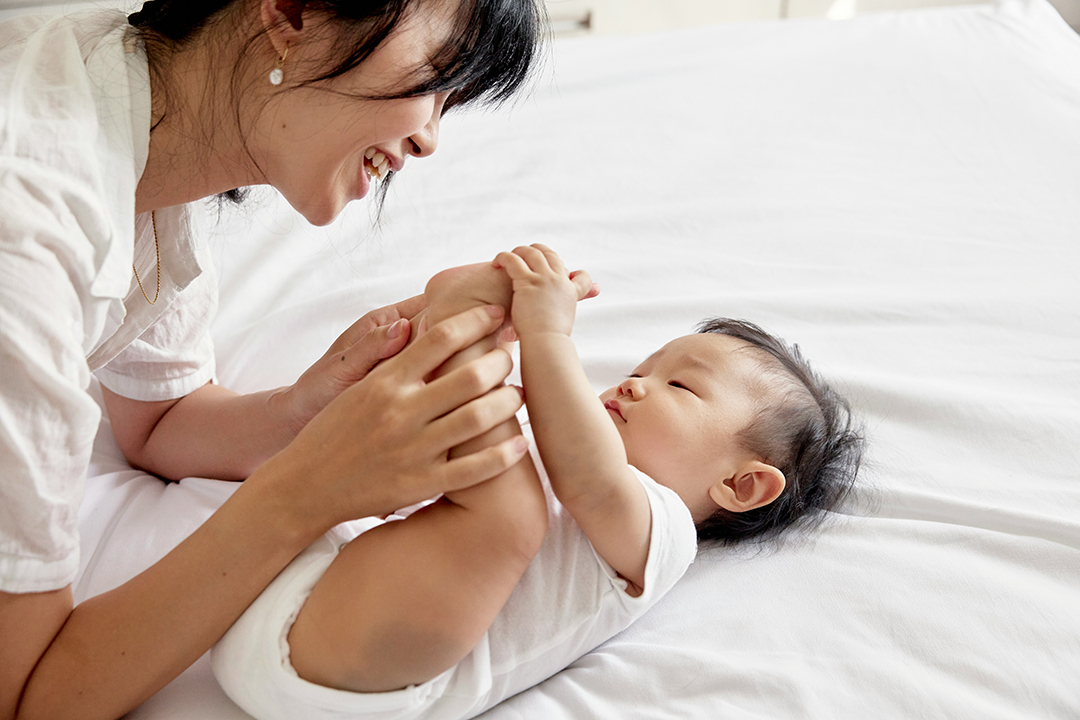Baby Banter Builds Babies’ Brains

The wide eyed baby turned in his wooden highchair seated on the restaurant patio overlooking the South China Sea as my family and I approached an adjacent table. His direct engaging look invited me to connect. I couldn’t resist his unspoken yet clear invitation. Maintaining eye contact as I sat down, I smiled and said, “Hello.”
He soaked me in with his focused gaze and the open relaxed facial expression of a 6-month-old boy ready to relate to me.
His mother, noticing him twisted around in his seat, smiled at me, then paid calm attention to him.
With a grin I spoke to him again, warmly, gently to make to a new friend, our eyes constant, “I’m glad to see you this morning. My name is Pam.”
Now he smiled a small smile and vocalized.
I returned his smile saying, “I’m glad to hear. What else?”
In a moment he made more sounds. We continued our delightful exchange.
After several responses I replied, “Thank you, I enjoyed being together. Have a tasty breakfast.” I also thanked his mother, who beamed as she encouraged him to eat.
Are those sustained gazes into your baby’s eyes useful? How about the chats that you worry you don’t have time for and that don’t seem to “accomplish anything” in the face of your endless list of what must get done? Are these interactions worthwhile?
In a word, YES!
Contingent “Serve and Return” Communication
These interactions, starting at a couple months of age, are crucial for emotional/behavioral health. Your baby’s brain grows 90% of its adult size in the first three years. As you welcome their serve be it eye contact, vocalizations or gestures—respond with a smile, steady soft eye contact, and notice what they pointed to. This ensures a strong flexible brain infrastructure. That sturdy brain structure promotes lifelong emotional health and the future capability of more complex brain activities. After you respond, pay patient attention and wait for their response. When it comes, respond again with warm joy and the conversation will unfold.
Respectful, warm, delight from you—without pressure on your baby to perform or please you with laughter—provides a safe space to connect and be themselves in that moment. We call these interactions, these conversations, “Serve and Return Communication.” Your baby develops brain structure, language, confidence and that vital connection with you. They thrive when feel seen, heard, and valued. Your baby may pull their legs up then push them out several times as they wave their arms exuding pure joy. You return the joy with smiles, soft eye contact, offering kind warmth and encouraging words.
“Serve and return interactions reinforce brain circuits that are at the core of early emotional well-being and social skills.” Harvard Center on Developing Child.
You being an attentive, responsive adult makes a lifetime of difference for your baby’s psychosocial, emotional, and intellectual wellbeing.
In Summary
Serve and Return interactions are worth every moment you can devote. According to the Harvard Center on the Developing Child, these bonding times together “support development of early language and social skills that serve as a foundation for more complex, high-level cognitive abilities”. These chats reinforce brain circuitry at the core of early emotional wellbeing and social skills. Your responsive, attentive relationship as a caring adult is key to building your baby’s brain structure as the strong foundation needed for future health and wellbeing.
How to Build Your Baby’s Beautiful Brain
- Notice the Serve—your baby making eye contact with you, babbling, or gesturing to you.
- Return the eye contact and add a warm, delighted smile and word of greeting.
- Slow down and pay thoughtful attention as you maintain eye contact.
- Await and then welcome the response.
- Sustain eye contact as you respond with words of encouragement and delight.
What are your experiences with Serve and Return?
Share you comments or questions.
